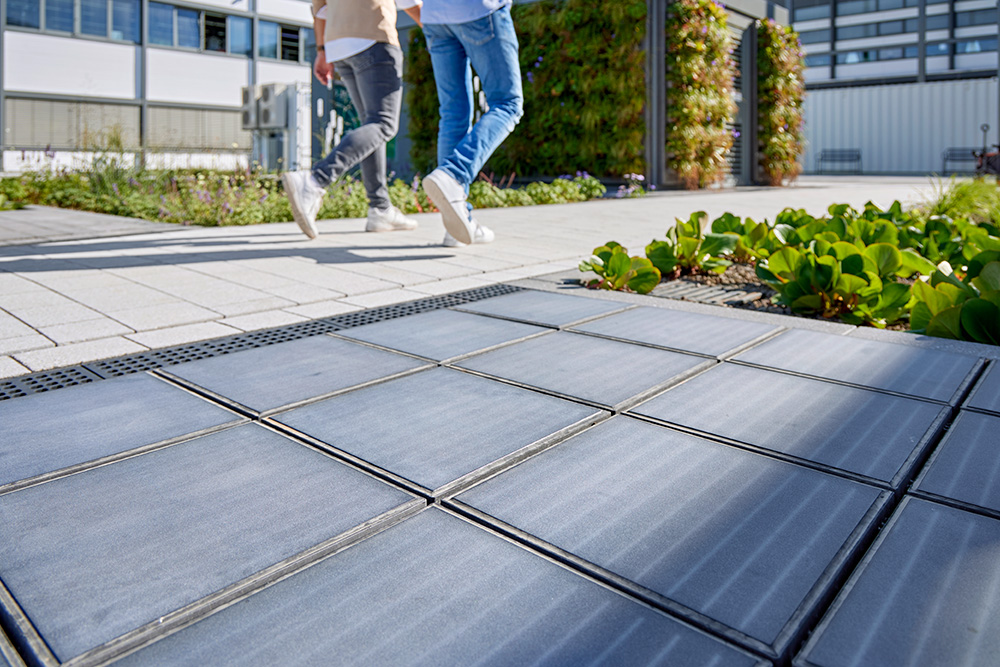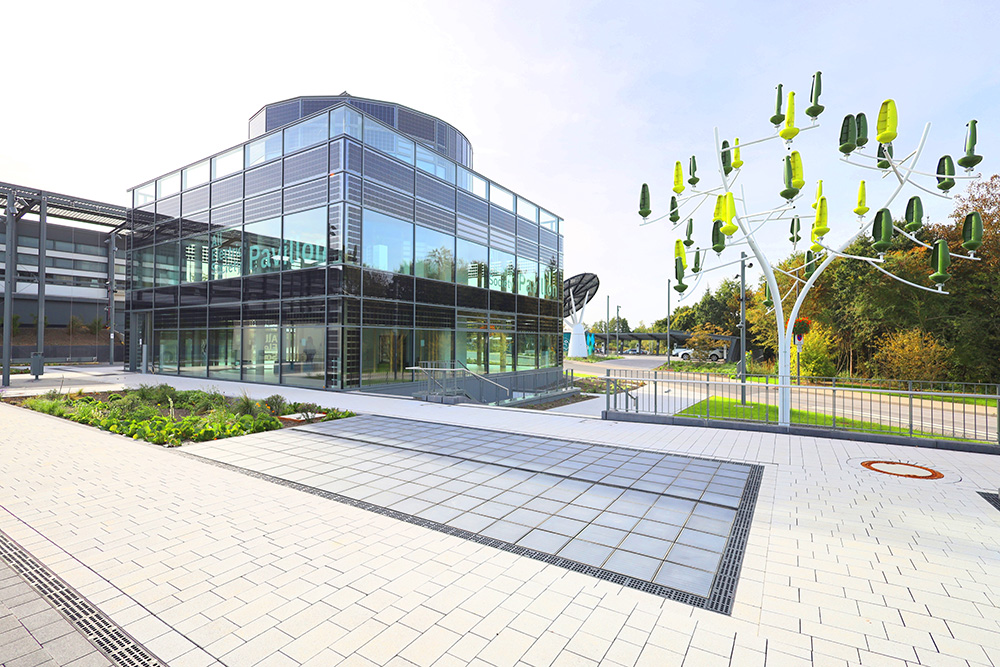The new landmark of Blomberg has a diameter of 12 meters, weighs 200 tons and is enthroned directly in front of the entrance to the Phoenix Contact company premises. The mighty solar tracker immediately signals that this is about the future. But it is not the only solar energy translator in the All Electric Society Park.
Maren Gast has captured the sun. Well, she helped with that. Because the engineer is a specialist when it comes to extracting the abundant energy from our celestial star. The sun: it brings 1.5 trillion kilowatt hours to earth every year. In less than an hour, it could cover our annual global energy needs.
Born in Hamelin, she is an expert through and through when it comes to harnessing this energy. Even before her studies, she was fascinated by this form of renewable energy. “I took my first professional steps as a chemical laboratory assistant in the field of semiconductors for solar energy before studying technical physics at the University of Applied Sciences and Arts in Hildesheim.” Two years in the further development of photovoltaics modules followed before she moved to Solar Power Industry Management at Phoenix Contact in 2012.
Follow the sun
If you don’t just look at the large solar tracker and its smaller 8-meter version right next door in the e-mobility area, you will quickly discover a number of other PV panels. “We have installed a total of 550 solar panels on walls, roofs, in the cubes, on carports and in the form of solar paving on sidewalks. In total, we achieve a gross output of 155 kWp with all the elements,” says the solar energy expert. “The two solar trackers are of course the real eye-catcher.” This little anecdote reveals just how dynamic the planning of the All Electric Society Park was: “Initially, only a few solar panels were to be integrated into the visitor pavilion. But we had a big meeting in Dubai in 2021 where these rotating structures were in use. And that’s where the idea of installing these power stations here was born.”




In contrast to conventional, stationary solar systems, the tracker follows the sun throughout the day, increasing the yield of energy generated by up to 45 percent. Maren Gast explains another special feature: “The 24 PV panels mounted on the huge steel structure are designed to be bifacial. This means that they are light-active on both their front and rear sides. This means that the light reflected by the structure is also collected. And this further increases the efficiency, 16.3 kWp is possible,” says the 46-year-old.

The original plan was to convert the direct current generated by the large solar tracker into alternating current in the solar cube 20 meters away. For safety reasons, it was decided against this: “Laying a 1000 V direct current line under a public road seemed too risky after all. Instead, we have now installed an inverter directly in the base of the tracker.”
Attention to the road: “We actually had to place the large tracker on a solid and raised concrete foundation, because as the traffic circle and tracker were built at the foot of a hill, we wanted to prevent trucks from crashing directly into the system in the event of a brake failure.”
Solar to step on it
Much fewer safety precautions were needed to install the 200 small modules, which can be stepped on. “Our solar paving is an innovation from the company Platio. Of course, the roughened but non-slip surface is not as energy-efficient as an elevated system on roofs or our trackers. But the idea of transforming the otherwise unused surface of sidewalks into power plants is simply captivating. And the 4.1 kWp generated here isn’t too bad either,” winks Maren Gast.



The 180 building-integrated panels that turn the visitor pavilion into an energy supplier are much more productive. “Vertical modules on the façade also ensure the energy use of areas that otherwise have hardly any functionality in the building. Overall, we achieve a yield of around 51 kWp here.” The engineer takes a look at the neighboring production halls. “Facades are still an undiscovered energy surface, especially in industrial buildings.”
Of course, the solar energy use of roof surfaces is standard. “At the very beginning, the plan was to equip the roofs of the cubes with air conditioning systems. But the concept was completely changed in the course of the rapid planning process. So these areas were available. And the carports above the e-mobility charging stations were not even planned at the beginning. They are now also important showcase areas to demonstrate where solar energy can be tapped.”
32 inverters are installed in the All Electric Society Park to turn the direct current generated into grid-compatible alternating current. If it is not consumed directly or stored in one of the energy storage units, the electricity flows into one of the two certified feed-in controllers that connect the park to the public power grid. “These feed-in controllers are a highlight of our product development at Phoenix Contact, because thanks to their certification, they take an enormous amount of work off the hands of specialist companies tasked with connecting larger decentralized systems from 135 kWp to the grid. Normally, they all have to go through complex approval and testing procedures as part of their commissioning.”



The individual specialist teams worked together intensively to monitor and control such diverse energy flows as those realized in the All Electric Society Park. “One of the biggest challenges was evaluating the large amount of data that is generated here due to the diverse energy generation options. We used an MQTT broker for this for the first time,” reports Gast. The MQTT broker is a server that acts as an intermediary between the individual devices. “To prevent the network from being slowed down or overloaded by too many different programming languages, we agreed on the MQTT interface variant.” This type of communication facilitates data communication between the individual participants. “This was also new territory for us. On a day-to-day basis, we naturally work on solutions in our respective specialist areas. Due to the interlinking of so many technologies and specialist areas, we had to work completely interdisciplinary and develop solutions. We also had a steep learning curve,” says Maren Gast.
Understanding through play
Too complicated? The All Electric Society Park is not just for technicians and engineers. A game has been developed to make the complex topic of electricity feed-in comprehensible. In the Solar Cube, visitors can take on the function of the feed-in controller and ensure that the power grid remains stable. The six treads built into the floor can be used to change the frequency by applying and removing load and ensure that the solar power is fed into the grid.
Maren Gast is certain: “The topic of solar power will continue to gain in importance in the future. The use of solar power at the All Electric Society Park in Blomberg shows what is already possible with today’s technologies. “Many companies and private individuals want to further reduce their CO2 footprint in the future. The park is a showcase for this. And we can also apply the learning curve we went through in the project to future customer projects.”
Facts
- 2 Solar tracker
- The new landmark has a diameter of 12 meters
- The large tracker weighs 200 tons
- There are a total of 550 solar panels in the park
- 180 building-integrated panels
- 220 sidewalk modules
- 32 Inverters





